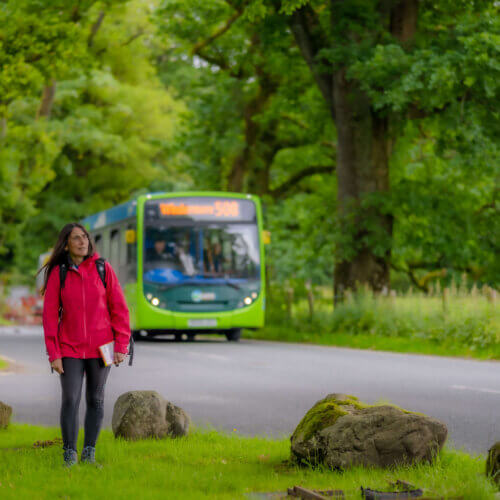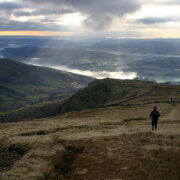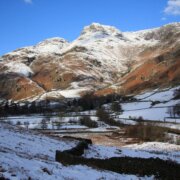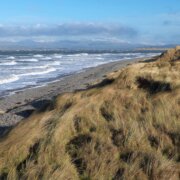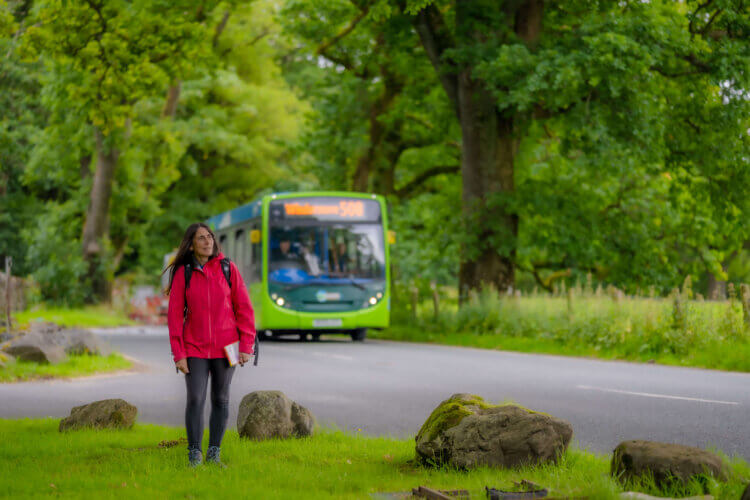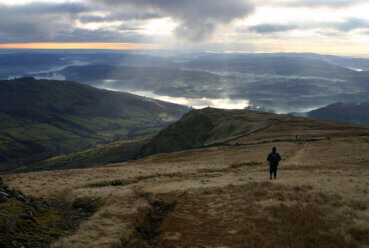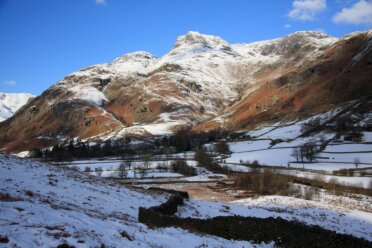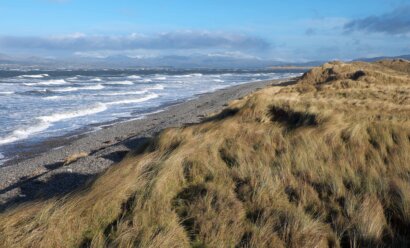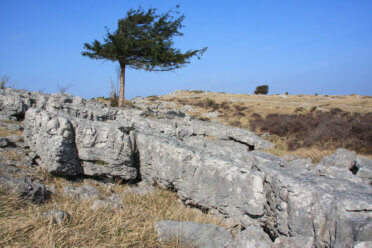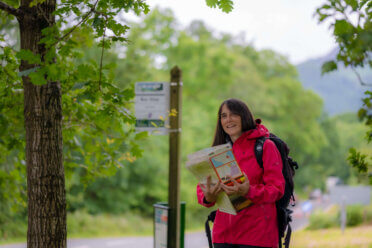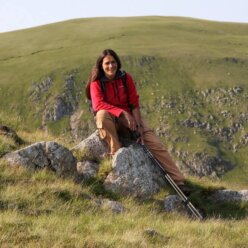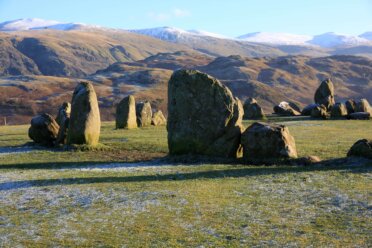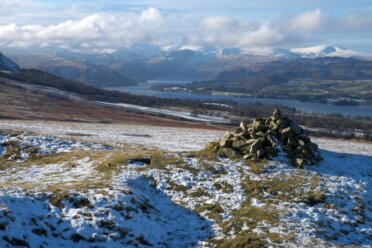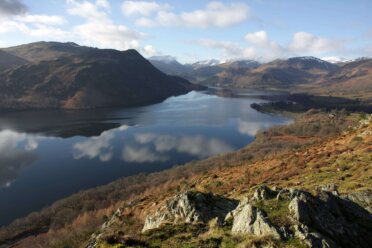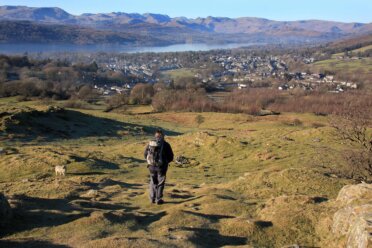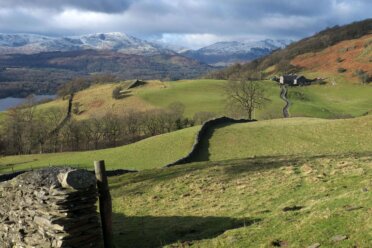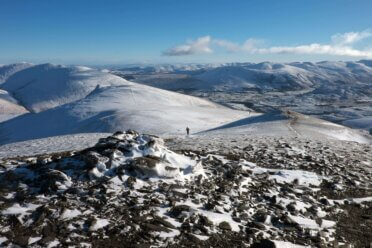You don’t have to relegate your walking boots to the back of the cupboard and don cosy slippers just because it’s winter. According to award-winning guidebook writer and photographer Vivienne Crow, the coldest season can lead to some of the best walking experiences, particularly when there’s snow on the fells. She’s come up with 10 walks that are suitable for the winter months, all accessible by Stagecoach bus.
The routes range from an invigorating 90 minute coastal stroll to an exhilarating six hour hike on the high fells. Most are low level, although you’ll still need to make sure you’ve got a map and are equipped for the terrain and changeable weather. Take a torch too as it gets dark early this time of year. If you are thinking of tackling one of the fell walks, check out the Adventure Smart website for advice as well as the National Park’s daily ground conditions reports.
For bus times, go to the Stagecoach website or download the Stagecoach Bus app from Google Play or Apple’s App Store. Pensioners travel free with a NoW card while everyone else pays only £2 per journey under the national fare-cap scheme, at least until December 31.
Walk 1: Castlerigg Stone Circle
Bus routes: 554, Lakes Connection 555, Borrowdale Bus 78 or X4/X5 to Keswick
Length/difficulty: 4¾ miles; easy; approximately 2¼ hours
Map: Ordnance Survey OL4, English Lakes NW
One of Britain’s oldest and most dramatically located stone circles, Castlerigg was built about 5,000 years ago, and it’s a place where crowds still gather on the winter solstice. Did the people of the New Stone Age build this monument as a calendar? Or as a religious site? Maybe it was a trading centre, a theory suggested after Victorian archaeologists discovered Langdale axe-heads here. Like so many similar prehistoric sites throughout Cumbria, Castlerigg remains an enigma – and an atmospheric one at that. Reaching the circle from Keswick is a straightforward affair, through woods, over fields and along quiet lanes, but always accompanied by views of some of our highest and most impressive mountains, including Skiddaw, Blencathra and the Helvellyn range. In that sense at least, little has changed since the circle was constructed in 3000BC. Return to Keswick – with its host of modern-day treats including coffee and cake, or pints of real ale – via quiet lanes and the Keswick Railway Path, which follows the route of the disused Cockermouth, Keswick and Penrith line.
Walk 2: Skiddaw Little Man
Bus routes: 554, Lakes Connection 555, Borrowdale Bus 78 or X4/X5 to Keswick
Length/difficulty: 9 miles; hard; approximately 6 hours
Map: Ordnance Survey OL4, English Lakes NW
If you can’t manage to get all the way up to the summit of England’s fourth highest mountain, this subsidiary peak is a good compromise. Located on Skiddaw’s south-east shoulder, Skiddaw Little Man can be reached directly from Keswick using the so-called ‘tourist’ path for much of the way. This constructed trail can feel like a bit of a slog at times, but it makes relatively light work of the climb and gives you lots of opportunities to enjoy the vista – to the west, a long line of high fells steadily unfurls, stretching from Grisedale Pike in the north to Bow Fell in the south. From the 2,837ft (865m) summit, the view also takes in Ullock Pike to the north-west, beyond which the Scottish hills are visible on a clear day. Far below, Derwentwater glints in the winter sunshine. To avoid a there-and-back walk, descend via Lonscale Fell, with its superb, bird’s-eye perspective on the steep-sided valley carved by the Glenderaterra Beck.
Walk 3: Heughscar Hill and the Cockpit Stone Circle
Bus route: 508 to Pooley Bridge
Length/difficulty: 6 miles; easy/moderate; approximately 3 hours
Map: Ordnance Survey OL5, English Lakes NE
The 508 bus calls in at Pooley Bridge on its way from Penrith to Patterdale. Alight at this popular village, at the northern tip of Ullswater, to access the lake shore and low fells that are dotted with Bronze Age remains. A surfaced lane and rough track lead up on to the moorland, where a network of trails criss-crosses Heughscar Hill, providing uninterrupted views of the lake below and the craggy mountains at its southern end. The next stop on this whistle-stop tour is the Cockpit Stone Circle, not as old or as dramatic as Castlerigg, but still wonderfully atmospheric. From here, descend with the Ullswater Way’s high-level option along the base of Barton Fell and then down to Crook-a-dyke. Here, we join the low-level Ullswater Way as it crosses farmland and skims the shores of Ullswater to return to Pooley Bridge. With buses running until late in the day, there’s time to enjoy some leisurely refreshments in one of the village’s many pubs or cafés.
Walk 4: Aira Force and Gowbarrow Fell
Bus route: 508 to Aira
Length/difficulty: 4 miles; moderate; approximately 2¾ hours
Map: Ordnance Survey OL5, English Lakes NE
Can it be true that the most spectacular view in the eastern Lake District is from a point little more than 1,000ft above sea level? And can it really be enjoyed on a straightforward walk from one of the National Park’s favourite beauty spots? Catch the 508 bus from Penrith to Aira, head up the spectacular Aira Gorge with its fascinating arboretum, see one of the Lake District’s most impressive waterfalls and then climb Gowbarrow Fell to find out. The outlook from the 1,578ft (481m) summit is good; the views of Ullswater as the path winds its way around the eastern edge of the fell are pretty special; but it’s the jaw-dropping scene to the south-west – suddenly revealed as the path rounds a bend on the southern side of the fell – that will literally stop you in your tracks. The western expanse of Ullswater is revealed, blue and inviting, with the dark, craggy Helvellyn range forming the perfect backdrop. Make sure your camera battery is fully charged because you’ll be taking lots of photos.
Walk 5: Staveley to Windermere via the Dales Way
Bus route: walk from Staveley and then catch the Lakes Connection 555 bus back from Windermere
Length/difficulty: 5½ miles; easy/moderate; approximately 3 hours
Map: Ordnance Survey OL7, English Lakes SE
Crossing low-lying, hilly ground between Staveley and Windermere, this charming linear walk follows the well-waymarked Dales Way for much of its gently undulating journey. Grab a picnic from the artisan bakery in Staveley’s Mill Yard and set off along quiet country lanes, over rough grazing land and across open, grassy hillsides. With snatched glimpses of the high Lakeland fells having come and gone, the route then abandons the Dales Way to climb to the viewpoint of School Knott. At 761ft (232m) above sea level, this tranquil spot marks the high point of the walk in more ways than one. From here, you get superb views of the northern end of England’s largest natural lake as well as the shapely Langdale Pikes. There’s no better spot to unwrap that picnic that’s been calling to you since you set off on your walk. Refuelled, drop north-west from School Knott to reach the edge of Windermere town for the 555 bus back to Staveley.
Walk 6: Orrest Head to Ambleside
Bus route: walk from Windermere and then catch the Lakes Connection 555 bus back from Ambleside
Length/difficulty: 8 miles; moderate; approximately 4¼ hours
Map: Ordnance Survey OL7, English Lakes SE
Like the previous walk, this one links two places served by the 555 bus. As with most linear walks, the views are constantly changing: one minute you’re gazing out across Windermere, the next you’re staring up into the wilds of the Kentmere fells or across to the Langdales. And with relatively steady gradients throughout and good going underfoot, you’ll have plenty of opportunity to appreciate fully these beautiful surroundings. Setting off from Windermere, the route first climbs Orrest Head, a viewpoint closely linked with the famous Lakeland guidebook writer Alfred Wainwright. While on his first proper holiday at the age of just 23, he experienced “a moment of magic” as he climbed to the top and soaked up the scene. Today, there are lots of benches from which to enjoy the view, but don’t hang around for long – it’s still several miles to Ambleside. The route crosses farmland and makes its way along walled lanes to reach Troutbeck. More walled lanes and tracks then lead to the atmospheric Skelghyll Wood before finally descending to Ambleside.
Walk 7: Red Screes
Bus route: Lakes Connection 555 to Ambleside
Length/difficulty: 7¾ miles; moderate/hard; approximately 5 hours
Map: Ordnance Survey OL7, English Lakes SE
Seen from Kirkstone Pass, Red Screes is a formidable-looking mountain – a mess of scree and crags rising almost vertically from the road. Approached from Ambleside, however, it becomes a more amiable fell with rounded, grassier slopes. Heading off from the village’s bus stands, this route starts with a lovely stroll along Scandale Beck, through woodland that is full of the sound of birdsong and the whooshing rush of the beck as it speeds through the steep-sided gorge. Emerging from the trees, you get to see more of the rugged scenery of Scandale, the narrow valley squeezed between the eastern arm of the popular Fairfield Horseshoe and the Snarker Pike ridge. Despite having a clear drove road running straight through it, this feels like a wild place as we steadily gain height. From Scandale Pass, the climb briefly becomes steeper and rougher. Finally, you reach the 2,545ft (776m) summit of Red Screes with its magnificent views that include the mountains of North Wales on a clear day. The route back to Ambleside uses an easy-going, grassy ridge path.
Walk 8: Great Langdale
Bus route: 516 to Elterwater
Length/difficulty: 7¾ miles; easy/moderate; approximately 3¾ hours
Map: Ordnance Survey OL7, English Lakes SE and OL6, English Lakes SW
Towered over by the iconic Langdale Pikes and culminating in the high wall of rock thrown up by the ridge comprising Crinkle Crags and Bow Fell, Great Langdale is one of Lakeland’s most dramatic dales. And, with the 516 from Ambleside making several stops in the valley – as far as the Old Dungeon Ghyll Hotel – the bus is the easiest way to access a host of excellent walks. If there’s snow on the fells or winter’s winds are raging, consider staying in the valley bottom and simply gazing up at those tremendous peaks. Starting from Elterwater, head through woodland and across open pasture as far as the Old Dungeon Ghyll. Turning downstream, you now follow a trail along the base of the Langdale Pikes and riverside paths, fringed in places by woodland. Alternatively, to stay out a little longer, consider extending the route beyond the Old Dungeon Ghyll to include a loop into Mickleden, adding just over 2 miles to the total distance but bringing a much greater sense of remoteness to the outing.
Walk 9: North Walney
Bus route: 2 to West Shore (Earnse Bay), Walney Island
Length/difficulty: 4 miles; easy/moderate; approximately 1½ hours
Map: Ordnance Survey OL6, English Lakes SW
Windswept Walney Island, just a 10-minute bus ride from the centre of Barrow-in-Furness, is home to two fascinating nature reserves. In the south is a Cumbria Wildlife Trust nature reserve, where the county’s only breeding colony of grey seal basks on the beaches. More easily reached from the West Shore bus stop though is the National Nature Reserve at the northern end of this long sliver of land. Here, you’ll find a range of habitats, including huge sand dunes, dune heath, mudflats, shingle beaches and salt marsh – all with a beguiling backdrop provided by the Lake District’s moody southern fells. Whatever time of year you visit, you’re guaranteed a wildlife spectacle. In spring, a chorus of natterjack toads, one of the UK’s rarest amphibians, can be heard at dusk; in summer, wildflower displays bring colour to the site; while, at this time of year, birdwatchers will be treated to large numbers of over-wintering waders, including huge, shimmering flocks of knots.
Walk 10: Whitbarrow
Bus route: X6 to Longhowe End, near Witherslack
Length/difficulty: 7¼ miles; moderate; approximately 3½ hours
Map: Ordnance Survey OL7, English Lakes SE
Lakeland and limestone? The two simply don’t go together, do they? But in the south of the National Park are some low fells that create a landscape more akin to North Yorkshire than Cumbria. One of these hills, Whitbarrow, is a National Nature Reserve that is home to several endangered species. The base of this gorgeous chunk of rock can be reached via a series of quiet lanes leading north-west from the X6 bus stop on the A590. The sheer cliffs, glimpsed through the trees, sparkle like silver in the winter sunshine as you make your way steeply up through woodland to the summit plateau’s limestone grassland. The first cairn is a great place to sit and take stock – behind, the meandering River Kent enters Morecambe Bay; to your right are the Howgills and the Yorkshire Dales; ahead are the Lake District fells – before reaching Lord’s Seat, Whitbarrow’s highest point. A steep path through a gap in the limestone scar then drops walkers at Witherslack before the route climbs up and over Yewbarrow’s shoulder to return to Longhowe End.
